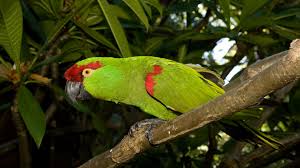
Thick-billed Parrot
Conditions of detention
Thick-billed Parrots are not typically kept as pets due to their conservation status and specific habitat needs. However, understanding their natural living conditions is important for conservation efforts. In the wild, they require mature pine forests with abundant food sources and suitable nesting sites.
Useful Fact: Thick-billed Parrots are highly social and live in flocks, relying on communal roosting sites and foraging in groups to find food.
Nutrition and diet
In their natural habitat, Thick-billed Parrots primarily feed on pine seeds, which they skillfully extract using their powerful beaks. They also consume other seeds, nuts, berries, and fruits available in their environment.
Useful Fact: The parrot’s thick beak is adapted for cracking open hard pine cones to access the seeds inside, making them specialists in their ecological niche.
Health
Thick-billed Parrots face threats from habitat loss due to logging and land development, as well as predation and competition for food. Conservation efforts focus on protecting their natural habitat and ensuring sustainable forest management practices.
Useful Fact: Thick-billed Parrots require healthy, mature pine forests to thrive, making habitat preservation crucial for their survival.
Grooming and care
In the wild, Thick-billed Parrots maintain their plumage through preening and dust bathing. Their natural grooming behaviors help keep their feathers in optimal condition.
Useful Fact: These parrots use dust bathing to remove parasites and keep their feathers clean, a behavior observed in many wild bird species.
Education and training
Thick-billed Parrots are intelligent and social, but due to their conservation status, they are not kept as pets and therefore not subject to training like domestic parrots. Conservation programs focus on understanding their behavior and ecology to aid in their protection.
Useful Fact: Thick-billed Parrots are known for their strong social bonds and complex vocalizations, which play a key role in communication within flocks.
Toys and entertainment
While not applicable for captive pet care, Thick-billed Parrots in the wild are naturally engaged in activities like foraging, socializing, and exploring their environment.
Useful Fact: In a natural setting, providing enrichment through habitat conservation ensures these parrots can engage in natural behaviors essential for their well-being.
Safety
Conservation efforts focus on ensuring the safety of Thick-billed Parrots by protecting their habitats from logging, development, and other human activities that threaten their survival.
Useful Fact: Conservation programs work to establish protected areas and promote sustainable forestry practices to safeguard the habitats of Thick-billed Parrots.
Accessories
In a conservation context, maintaining natural nesting sites and ensuring an abundance of food resources are critical for the survival of Thick-billed Parrots.
Useful Fact: Thick-billed Parrots nest in tree cavities, relying on mature forests with large trees that provide suitable nesting sites.
Socialization
Thick-billed Parrots are highly social and live in large flocks, which provide protection, communication, and cooperation in foraging and breeding.
Useful Fact: These parrots rely on social interactions for survival, with flocks often moving together between feeding and roosting sites.
Travel and Transportation
Thick-billed Parrots are naturally migratory within their range, moving between different areas in search of food as pine cone crops vary.
Useful Fact: Seasonal movements are a natural part of their behavior, allowing them to exploit different food sources throughout the year.
Behavior and psychology
Thick-billed Parrots are intelligent and exhibit complex behaviors, including vocal communication, social bonding, and cooperative foraging.
Useful Fact: Their vocalizations are important for maintaining group cohesion and communication within flocks, especially in dense forest habitats where visual contact may be limited.
Legal aspects
Thick-billed Parrots are protected under international and national conservation laws due to their status as an endangered species. Captive breeding and conservation programs are critical for their survival.
Useful Fact: The Thick-billed Parrot is listed on CITES Appendix I, which regulates international trade to prevent exploitation and supports conservation efforts.


